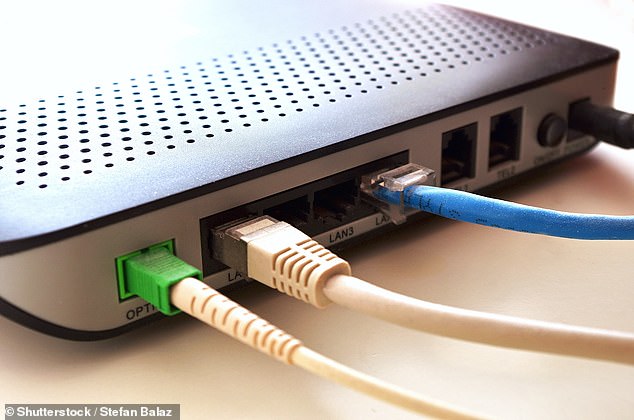People are just realizing that these seven household items can slow down your Wi-Fi
>
Tucking away an often clunky and unsightly wireless router can be great for the vibe of your home or office, but placing it next to the wrong device can dramatically limit its range.
Most Wi-Fi routers broadcast their signal on one of a few standard frequencies, 2.4 gigahertz (GHz), 5 GHz, and 6 GHz.
Placing other electronics that operate on the same frequencies can therefore obviously disrupt your connection.
But there are a few other less intuitive ways you can slow down your own internet speed.
Below are seven common household items that may be slowing you down on the internet:
Experts say putting a router in the kitchen near a microwave is one of the worst places to put it
Shiny surfaces such as metals and mirrors
Light, like microwaves and radio waves, are all part of the electromagnetic spectrum of radiation.
So just as light bounces off a glossy surface and sends your reflection back at you, a large mirror or shiny metallic sheen can deflect a wireless router’s signal in unintended directions.
These striking home decorations can contribute to mysterious ‘signal dead zones,’ where even your brand new devices can struggle to stay online.
Microwave ovens
Microwave popcorn is essential for watching your favorite streamers, but that doesn’t mean the kitchen appliance has to be near your router.
Electromagnetic radiation seeping from your microwave ovens can effectively produce a radio signal at 2.4 GHz, just like many standard Wi-Fi routers. Therefore, you may notice a glitch in your movie if you eat snacks again during intermission.

Adding boosters and keeping the technology up to date will also benefit the internet signal at home
Large furniture and other dense objects
An imposing antique wardrobe, longcase clock, or dense marble sculpture similar to a large aquarium can weaken your router’s signal if it gets in the way.
The wavelengths of the usual WiFi frequencies for a local area network or LAN channel is 4.92 inches for 2.4 GHz, 2.36 inches for 5 GHz, and 1.97 inches for 6 GHz.
These radio waves are dramatically shorter than the waves used in radio or old TV broadcasts, so they are slightly more likely to experience degradation as they pass through a solid object. This process is technically known as attenuation.
Bottom line: Don’t hide your Wi-Fi behind something big.
Cordless telephones
You may not have seen a cordless phone since the last time you watched the original 1996 horror movie “Scream,” but if you still have one of these ’90s antiques in your home, keep in mind that these too just like microwave ovens can break down. your download speeds mercilessly.
Bluetooth devices
Again, as with microwave ovens and cordless phones, any Bluetooth devices such as speakers or digital projectors can get in the way of a Wi-Fi signal if they are too close to the router.
Given the variation in signal strength, you may want to test some distances yourself, not only for the best sound but also for the best reception, before landing on a good spot for your speakers.
Other electronics
There are a few unusual and brand-specific instances where everything from baby monitors to fluorescent lights have proven to get in the way of an Internet connection by emitting frequencies close to the standard wireless GHz range.
Clearing unnecessary electronics away from your router or investigating its proximity through trial and error can reveal the culprit that is holding you back.
If none of the above are feasible, consider purchasing a powerline adapter, Wi-Fi extender, or any other tool that can boost the Internet signal.
Adapters use the electrical wiring in a home to carry a broadband signal to different rooms. These devices can be plugged into a few outlets, the experts explain, expanding wired connectivity in any room you want.
The only trick is to find one that matches your decor.
Aquariums and other large liquid containers
If the volume of liquid is large enough, it can absorb the radio wave frequencies, blocking everything between your router and your laptop, phone or tablet.
This same phenomenon is why submarines use SONAR, which is based on sound waves, instead of RADAR, which is based on radio waves which are simply not that useful in the depths of the ocean.
Sometimes even small drops of water can be enough to get in the way.
As two computer researchers put it The conversation“Wireless signals outside the house or building can be affected by rainfall, as water droplets can partially absorb the signal, resulting in a lower coverage level.”
